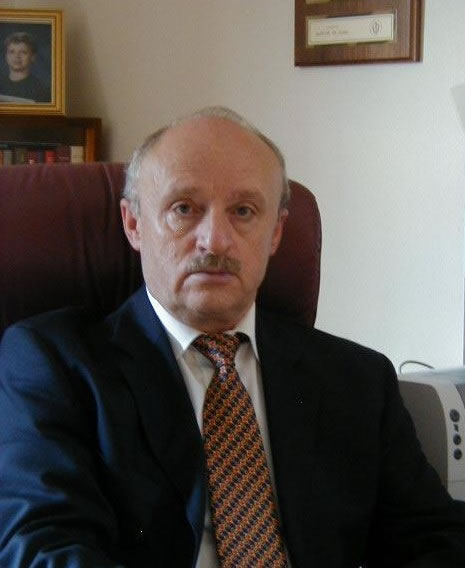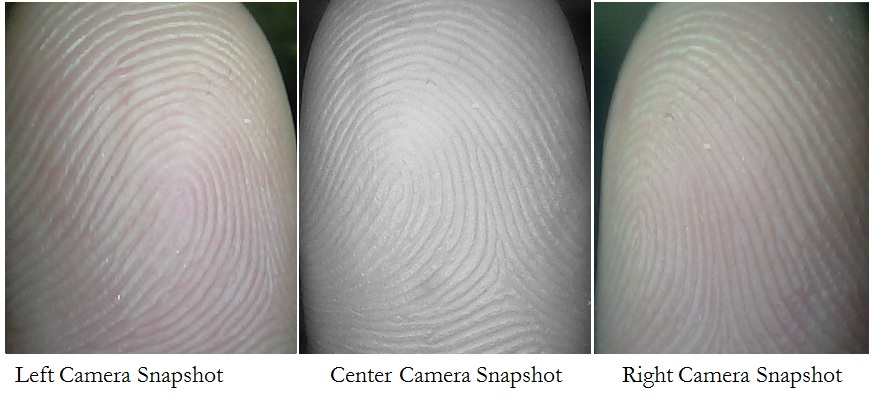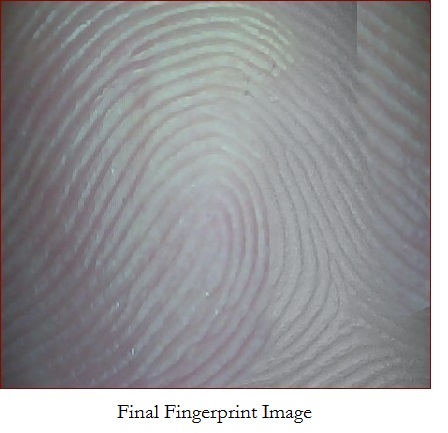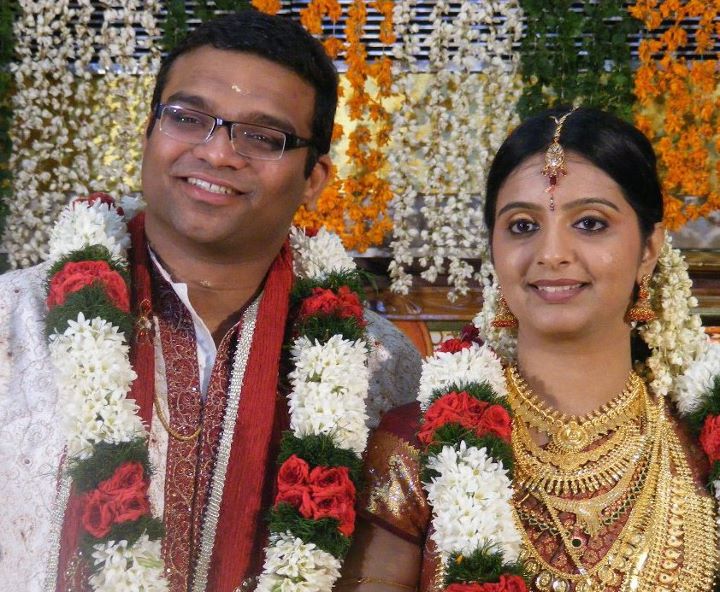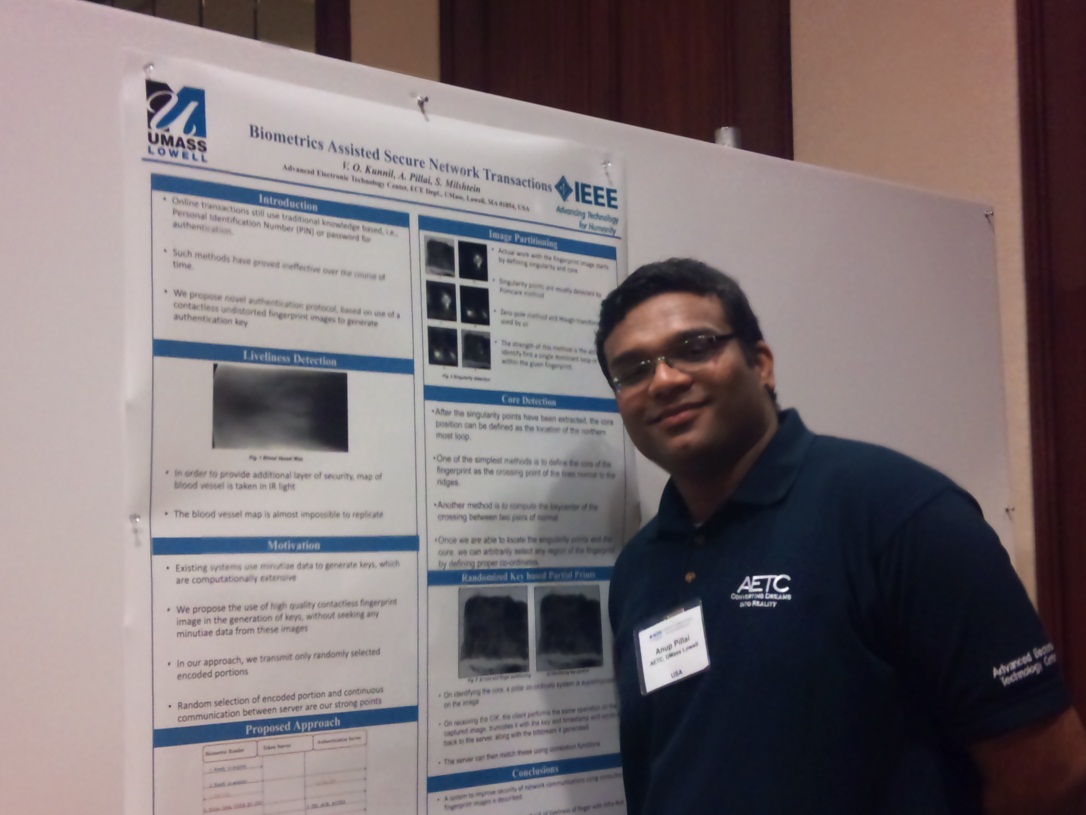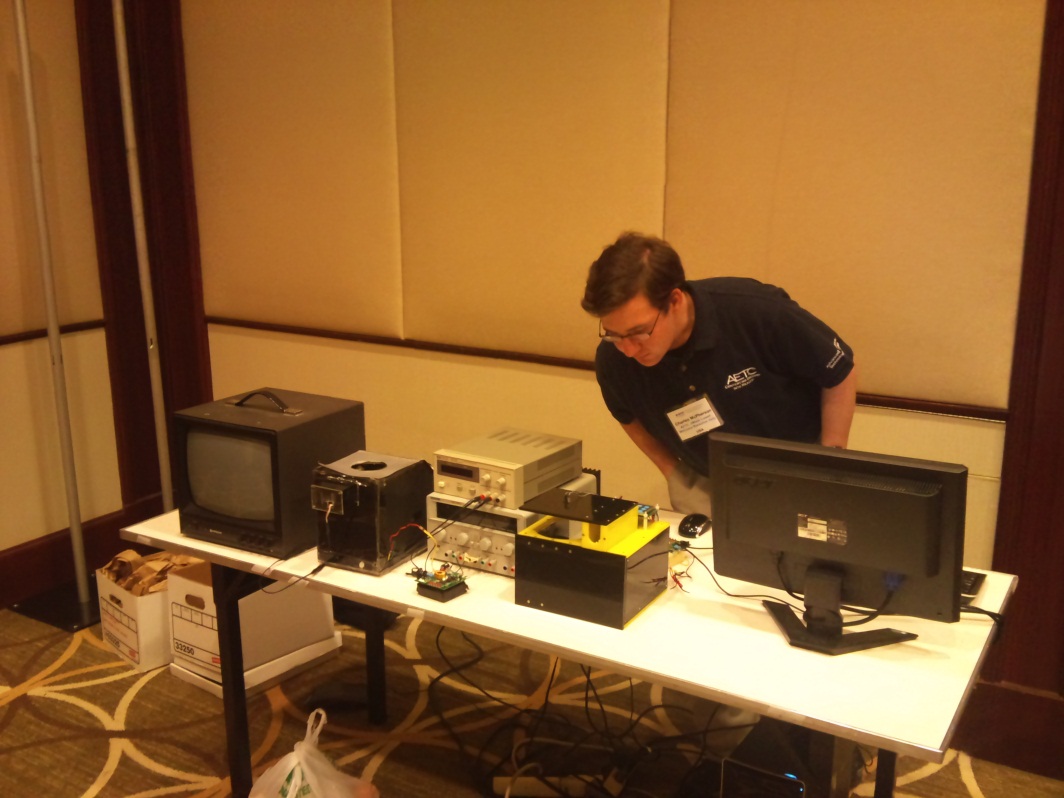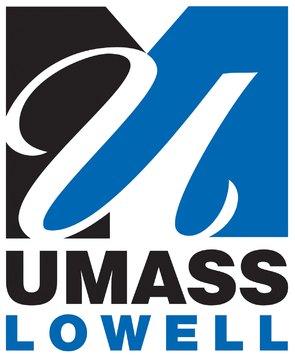
Advanced Electronic Technology Center We believe in Converting Dreams to Reality
___________________________________________________________________________________________________
Important Events at AETC in 2017
AETC Undergraduate student Mukhammaddin Zinaddinov received the ECE Outstanding Undergraduate Student in Research Award.
In academic 2016-2017 year Prof. S. Mil'shtein was elected to serve as a member of organizng committee at three international conferences:
- 1. International committee of Quantum Electronics Conference on Low Dimensional Systems and Devices LDSD-2016”, August 2016 in Cancun, Mexico.
- 2. Organizing committee of International IEEE Technology for Homeland Security Conference -2017”, April 2017, Waltham, MA.
- 3. Organizing committee of IEEE International MWCAS Conference, August 2017 in Boston, MA.
Mukhammaddin Zinaddinov presentation at the IEEE International Technologies for Homeland Security Conference in Waltham, MA
At the end of April 2017 ECE B.Sc. student of ECE Dept., Mukhammaddin Zinaddinov presented his research on "Two-mode Biometrics Using Fingers". Congratulations Mukhammaddin! The picture below is one of the moments of the presentation made at the conference.
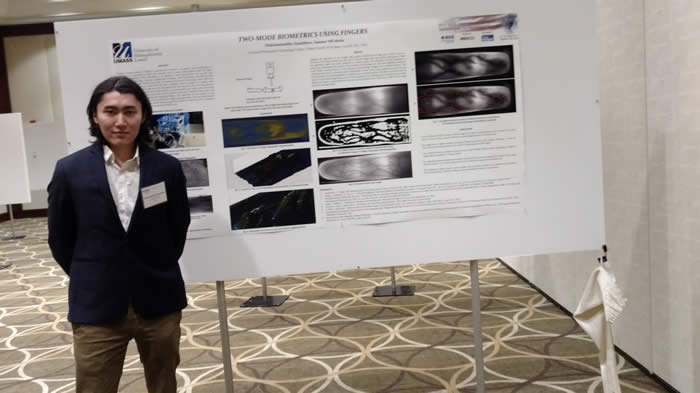
Important Events at AETC in 2016
Bill Brooks impressive presentation at the International Conference in Cancun, Mexico
At the end of August 2016 ECE M.Sc. student of ECE Dept., Bill Brooks was traveling together with Prof. Sam Mil’shtein to the International Quantum Electronics Conference, LDSD-2016, which was held in Cancun, Mexico. Bill Brooks presented at the Conference his research results produced together with ECE Dept. doctoral student, Huan Wang. The novel idea and, mostly, high quality of Bill’s presentation was assessed by the Conference Committee to be the second best student talk of the conference. Congratulations Bill! The picture below is one of the moments of the presentation made by Bill Brooks.

AETC undergraduate student, Mukhammaddin Zinaddinov, received for the second year in a row another prestigious award, which is designed for best foreign students.
AETC undergraduate student, Mukhammaddin Zinaddinov, received for the second year in a row another prestigious award, which is designed for best foreign students. Jeffrey Cosiol International Merit Scholarship provides scholarships to international students pursuing a degree in the Francis College of Engineering. Among most important achievements of Mukhammaddin is not only his high GPA but the fact, that during the freshman and sophomore years he completed the study of junior year as well and became to be senior in Fall semester 2016. Together with good scholastic achievements being 3.8/4 Mukhammaddin is very active in research. Two of his studies on efficient heterostructured solar cells were presented at International IEEE 43rd Conference of Photovoltaic Specialists in June 2016. His biomedical studies on blood vessels in human fingers were submitted for publication to IEEE Biometrics Journal in August 2016.
In Spring semester of 2016 the team of undergraduate ECE students together with students of Nashoba Technical high school led by Mukhammaddin did designed and built a solar powered lawnmower. The lawnmower was tested in July 2016. Currently Mukhammaddin is engaged in redesign of four-wheel solar/electric car. In that project together with students from ECE and ME Mukhammaddin is responsible for programming and control of the powertrain of the new vehicle.
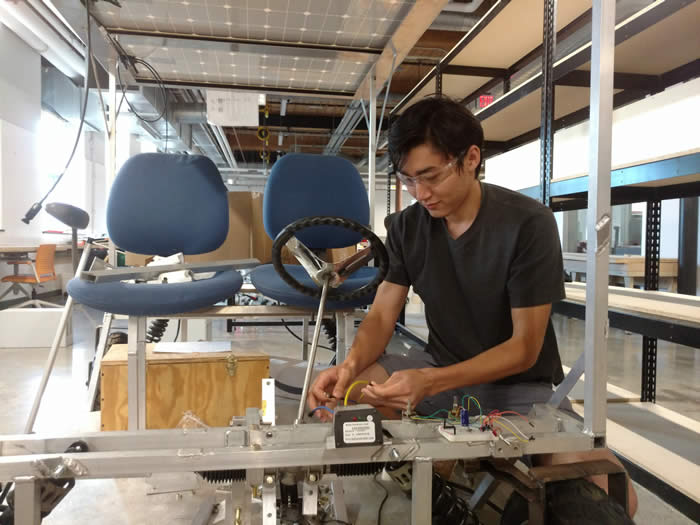
Important Events at AETC in 2015
AETC is proud to announce that an undergraduate student Mukhammaddin Zinaddinov received a special award as one of the best ECE Dept undergraduate students.
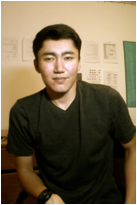 Mukhammaddin Zinaddinov graduated from the National Specialized Physics and Mathematics High School in Almaty, Republic of Kazakhstan. It is considered to be the best high schools in Kazakhstan. The school accepts only students with high academic performances. Mukhammaddin was one of the few students, who were accepted with no additional tests due to his achievements in math competitions on a regional level. Mukhammaddin was the number one student in his class. He demonstrated again high academic performance and graduated with all “A” grades except the only “B” in Russian language. M. Zinaddinov SAT subject scores for Mathematics Level 2 and Physics were 760 and 770 correspondingly. His freshmen, 2014 -2015 academic year at UMass was rather challenging but successful with GPA score 3.89/4. The score is high and considered to be excellent as it was achieved by student, whose native language is not English. Mukhammaddin successfully combined academic studies with participation in two research projects. His participation in building third generation solar/electric taxi and leading role in improving mammography diagnostics was very welcomed and appreciated by his team mates. M. Zinnaddinov achievements were noticed by management of UMass. At the end of his freshmen year Mukhammaddin was awarded endowed William and Elizabeth O’shia scholarship as one among the best undergraduate Electrical Engineering students. Being extremely busy with courses and research activities Mukhammaddin does not forget his hobby of drawing. You might be interested to see below one of his sketches.
Mukhammaddin Zinaddinov graduated from the National Specialized Physics and Mathematics High School in Almaty, Republic of Kazakhstan. It is considered to be the best high schools in Kazakhstan. The school accepts only students with high academic performances. Mukhammaddin was one of the few students, who were accepted with no additional tests due to his achievements in math competitions on a regional level. Mukhammaddin was the number one student in his class. He demonstrated again high academic performance and graduated with all “A” grades except the only “B” in Russian language. M. Zinaddinov SAT subject scores for Mathematics Level 2 and Physics were 760 and 770 correspondingly. His freshmen, 2014 -2015 academic year at UMass was rather challenging but successful with GPA score 3.89/4. The score is high and considered to be excellent as it was achieved by student, whose native language is not English. Mukhammaddin successfully combined academic studies with participation in two research projects. His participation in building third generation solar/electric taxi and leading role in improving mammography diagnostics was very welcomed and appreciated by his team mates. M. Zinnaddinov achievements were noticed by management of UMass. At the end of his freshmen year Mukhammaddin was awarded endowed William and Elizabeth O’shia scholarship as one among the best undergraduate Electrical Engineering students. Being extremely busy with courses and research activities Mukhammaddin does not forget his hobby of drawing. You might be interested to see below one of his sketches.

The "Lowell Sun" published in the news the following article about AETC Solar Powered Taxi : Link
Professor S. Mil’shtein was elected to serve on Organizing Committee of 4th International NASA Conference on Nanotechnology, Energy and Space. The conference will run on May 12 – 14, 2015 in San Antonio, TX. : Link
Professor S. Mil’shtein was appointed to serve as the Chairman of International Electrical Engineering Congress (Link), which will run on July 13 -15 in Barcelona, Spain. The Congress is comprised of 4 different Electrical and Computer Engineering Conferences.
Dr. Samson Mil’shtein is a Professor of Electrical and Computer Engineering of University of Massachusetts at Lowell since 1987. From 1990 he is the director of the Advanced Electronic Technology Center at UMass. During 1998-1999 he served as Assistant Dean of Engineering for Research, UMass, Lowell, MA.He received his M. Sc. Degree in Semiconductors from State University of Odessa (Ukraine), and Ph. D. from University of Jerusalem (Israel). At age 23 he was the youngest professor of Semiconductor Electronics Department, Polytechnic College of Kherson (Ukraine). Dr. Mil’shtein worked for semiconductor companies in Russia and the USA, was teaching at Russian and Israeli Colleges, served as research fellow in Russian Academy of Sciences and at AT&T Bell Laboratories.Working as a member of the research staff with the Institute of Solid State Physics, Russian Academy of Science, he received in 1971 the first prize of ISSP of the Academy for the discovery of dislocation based p-n junctions in Si and Ge. This discovery led to the design of the “Smallest Transistor” with the extremely short channel.His publication list carries over 260 publications, patents, and conference presentations. His current research work covers high speed quantum electronics, design of solar sell systems, imaging systems for biometrics and medical engineering applications.
Sam Mil'shtein
Department of Electrical and Computer Engineering, University of Massachusetts at Lowell
During May 2015 Prof. S. Mil’shtein was traveling to Republic of Kazakhstan. He was invited to speak at Economic Forum – 2015. Economic Forum is the part of International Meeting of G-200. Countries such as Australia, Japan, countries of Africa and Latin America are participants of G-200 conferences. At the energy section of the Forum Prof. S. Mil’shtein presented the talk entitled “Future of Solar/Electric Transportation”. The presentation described design and work of AETC students. High interest of the audience and informative facts discuss in the presentation made this talk one of the best presentations at the Forum.
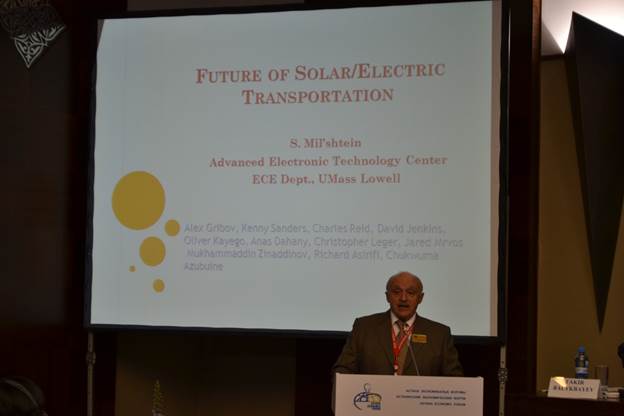
On May 22nd Prof. S. Mil’shtein was invited to be present at the general meeting of Academy of Science of the Republic of Kazakhstan. In this meeting the members of Academy voted to elect Prof. S. Mil’shtein as a member (Academician) of the Kazakh Academy. Being absolutely not prepared for the surprise Prof. Mil’shtein needed help of two people to ware properly the academic hat and academic gown. At the picture below (the hat and the gown already in place) the President of Academy N. Aktybaev presents to Sam Mil’shtein the special diploma.
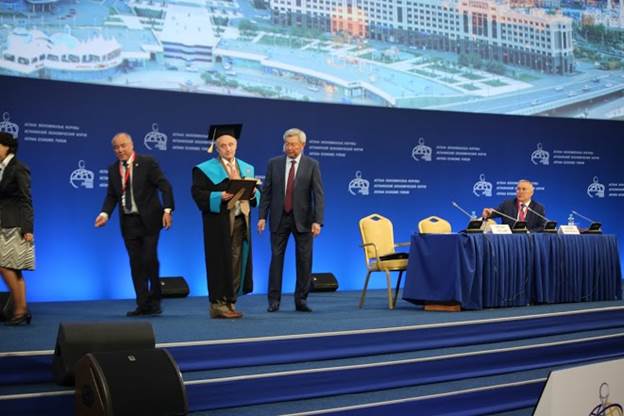
Martin Margala Awarded Fulbright Chair at FEE CTU
Professor Martin Margala has been awarded the Fulbright-CTU Distinguished Chair position at the Faculty of Electrical Engineering, Czech Technical University. His 1-year fellowship will start September 1, 2015.
Martin Margala is currently the Chair of the Electrical and Computer Engineering Department, University of Massachusetts Lowell and Co-director of AETC. His research interests are within Digital & Mixed-Signal VLSI Design & VLSI Testing.
At the FEE CTU he will perform research to develop a novel monitoring method for tracking the behavior of power management circuits in real-time. This is a hot topic, because power management is a weak point of the ultrafast processors of the future. He will also teach one core undergraduate course and one technical elective, advanced course, targeting seniors and graduate students each semester. Besides that he plans to conduct other important activities, such as reviewing teaching methods and styles in courses where the instruction is conducted in English, Participating as an academic research advisor on PhD committees, Designing a workshop on academic writing. Advising on the design of new strategies for the International Office at the FEE CTU.
The Fulbright Program is the U.S. government’s flagship international educational exchange program, sponsored by the Bureau of Educational and Cultural Affairs of the United States Department of State. Since its inception in 1946, the Fulbright Program has provided more than 300,000 participants—chosen for their academic merit and leadership potential — with the opportunity to study, teach and conduct research, exchange ideas and contribute to finding solutions to shared international concerns. 8 000 outgoing and incoming fellowships are awarded annually. The Core Fulbright U.S. Scholar Program sends approximately 800 American scholars and professionals per year to 130 countries. Awards in the Fulbright Distinguished Chairs Program are the most prestigious appointments in the Fulbright Scholar Program, which are given only to approximately 40 eminent scholars. Four of them are in the Czech Republic: at the Charles university, the Masaryk University, the Palacky University and the Czech Technical University. Fulbright program in the Czech Republic is jointly sponsored by the U.S. and Czech Governments. Fulbright Distinguished chair awards are also sponsored by the host institution.
We wish Martin Margala a pleasant stay in Prague !
Important Events at AETC in 2014
Prof. S. Mil’shtein was invited to talk at Energy Forum of G-120 International Meeting on May 22, 2014 in capital of Kazakhstan, Astana. The novel heterostructured solar cells design by AETC team made very positive impression on the delegates of the Forum.Prof. S. Mil’shtein was interviewed by local newspaper and agreement of cooperation between Institute of Physics and Technology (IPT) Kazakh National Academy of Science and AETC was signed by Prof. S. Mil’shtein and Prof. Serekbol Tokmoldin, Director of IPT. The video clip about signing this agreement was shown at local news.
Below is the picture from The Energy Forum Moment of signing the agreement between AETC UMass and IPT Academy of Science, Republic of Kazakhstan.
Moment of signing the agreement between AETC UMass and IPT Academy of Science, Republic of Kazakhstan.
At the same Energy Forum in Astana for the first time was shown a solar/electric bike build by AETC students. The interest to that project resulted in joint effort of AETC and Academy of Science of Kazakhstan to build small size solar/electric car. In June 2014 the solar /electric “taxi” for four passengers was designed and build by AETC students. Shortly the first publication about student achievement appeared in UML and UMass publications. In Fall 2014, the “taxi” was modified significantly and design of a small solar/electric car started. AETC students that participated in the building of the vehicle: Chris Leger, Anass Dahany, Alex Gribov, Kenneth Sanders, Oliver Kayego, Jared Mvos, Mukhammaddine Zinaddinov.
Prof. S. Mil’shtein participated in 2011-2012 NASA events: 50th Aniversary of Man Flight in Space
In 2011 the world celebrates 50th anniversary of the first man in space, the flight performed by Russian cosmonaut Uri Gagarin. To celebrate this remarkable date four members of NASA delegation (Profs. A. Ignatiev, A. Freundlich (both from University of Houston) Mrs. S. Tabarovsky, member of Organizing Committee (Houston) and S. Mil’shtein (UMass) traveled to the first Eco-center established in Kaluga district, to visit newly opened monument of U. Gagarin. and to set a corner stone for the monument of first man on the moon, American cosmonaut Neil Armstrong (see pictures below). Russians keep very high regards with the first astronaut stepped on the surface of the moon, Neil Armstrong.
Prof. S. Mil’shtein was invited to talk about principles of design of high efficient solar cells at “Second International NASA Symposium on Nanotechnology and Energy in Space”. The Symposium was held at Chernogolovka Research Center of Russian Academy of Science, near Moscow on August 1 – 6, 2011.
The first high efficient solar cell, described at the Symposium, was designed by UMass students at ECE Dept., Advanced Electronic Technology Center and is already produced by students of Houston University. The cooperation between two groups will continue in fabrication of the second solar cell designed at UMass.
Attendees of the Symposium were invited to visit the Star city, the Space Research Center of Russian Academy of Science. We were watching the alive preparation of Russian cosmonaut supervised by an instructor for coming soon space flight. Although we were allowed to take all kind of pictures at the Center floor, but we were asked by Russian authorities not to mention the names of the cosmonaut, who is preparing for coming soon flights. We also had the pleasure to meet Russian cosmonaut Sergei Krikalev.
There are 523 cosmonauts around the globe, however only Sergei Krikalev participated in six different space flights. As it was two years ago (during the First NASA symposium in Houston) at the dinner with American cosmonauts, the friendly environment was present at this time as well. Sergei Krikalev was openly answering questions about his personal experience, his training and some exotic situations he was part of in some flights. Russian engineers and space scientists openly expressed regrets about ending of the American shuttle program, which was the platform for very successful cooperation of the two countries.
On October 12th 2012 Prof. S. Mil’shtein did attend opening of the Uri Gagarin and Neil Armstrong monuments at first NASA headquarters in Houston and put together with members of NASA committee Profs. A. Friendlich and A. Ignatiev (both of University of Houston) red roses.
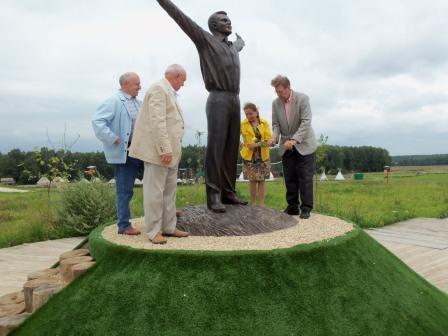
Picture 1: Uri Gagarin monument (from left to right)
Dr. O. Pcheliakov (Russian Academy of Science), Prof. S. Mil’shtein (UMass),
Mrs. S. Tabarovsky (NASA) and Prof. A. Ignatiev (Houston University)

Picture 2: Opening of the corner stone for the Neil Armstrong monument (from left to right) Prof. A. Ignatiev wearing glasses (Houston University), Mrs. S. Tabarovsky (NASA) Prof. S. Mil’shtein (UMass), Dr. O. Pcheliakov (Russian Academy of Science), and Prof. M. Henini (following the group) (United Kingdom)
It was than planned to open the monument for Uri Gagarin and for first American austronavt, who orbited the Earth, John Glen in Houston. John Glenn was selected to operate the experimental Mercury spacecraft in the Friendship 7 mission on February 20, 1962. On October 29, 1998, he became the oldest person to fly in space, and the only one to fly in both the Mercury and Space Shuttle programs, when at age 77, he flew on Discovery.
The ECE newsletter did highlight this Moscow event recently.
In 2012 the world celebrated 40th anniversary of the first man reaching the moon.
The first man on the moon, American cosmonaut Neil Armstrong. He made his first space flight, as command pilot of Gemini 8, in 1966, becoming NASA's first civilian astronaut to fly in space. On this mission, he performed the first docking of two spacecraft, with pilot David Scott.
N. Armstrong's second and last spaceflight was as mission commander of the Apollo 11 moon landing, in July 1969. On this mission, N. Armstrong and Buzz Aldrin descended to the lunar surface and spent two and a half hours exploring, while Michael Collins remained in lunar orbit in the Command Module. Unfortunately on August 5th 2012 Neil Armstrong, passed away.
In 2012 US government and NASA made a decision to install monuments for Uri Gagarin and John Glenn in Houston, TX. On October 12th 2012 Prof. S. Mil’shtein did attend opening of the Uri Gagarin and John Glenn monuments at first NASA headquarters in Houston and put red roses to both monuments together with members of NASA committee Profs. A. Friendlich and A. Ignatiev (both of University of Houston) See figures bellow. The celebration evening took place in Russian consulate in Houston with many Houston dignitaries, representatives of Russian government and NASA officials. Uri Gagarin’ daughter Ludmila and his grandson Sergei were among gests invited by NASA.
Very open and sincere discussion with the general manager of Russian shuttle program revealed that this program being seven year old did not progress much due to the number of factors. It was regretfully admitted the missing American cooperation in Russian efforts to launch the shuttle from the big flying plane. Looking back at successful American – Russian space cooperation one can hope that in the near future these two countries will join forces in space again.
_______________________________________
Picture 3. Profs A.Ignatiev (left), S. Mil’shtein (center), A. Friendlich (right) at the John Glenn monument in Houston

Picture 4. Profs A.Ignatiev (left), S. Mil’shtein (center), A. Friendlich (right) at the Uri Gagarin monument in Houston.
The continuous commitment of UML Advanced Electronic Technology Center to develop novel, lightweight solar cells for space applications was discussed during Professor S. Mil’shtein visit to Houston.
_________________________________________________________________________________________________________________________________________________________________________________
Important Events at AETC in November 2012
On November 9th doctoral student Anup Pillai defended his Ph.D. thesis. The dissertation committee of professors C. Armiento, M. Mufeed, and S. Mil’shtein did agree that the research presented novel development in fingerprinting technology and image processing. However a curious twist took place at the defense. The members of the committee demanded that 60 plus pages describing Anup’ research are not long enough and additional wording needed. That is how Anup did find himself “entrapped” by Prof. S. Mil’shtein’ requirements that novel engineering developments should be described by minimum wording to deliver patentability and cost efficiency aspects of any new technology. Fortunately Anup did have additional material which he included into his thesis. Professor Mil’shtein, on his part, did promise never again to undermine the graduate students thesis’s by his ergonomic requirements.
Congratulations Dr.Anup Pillai
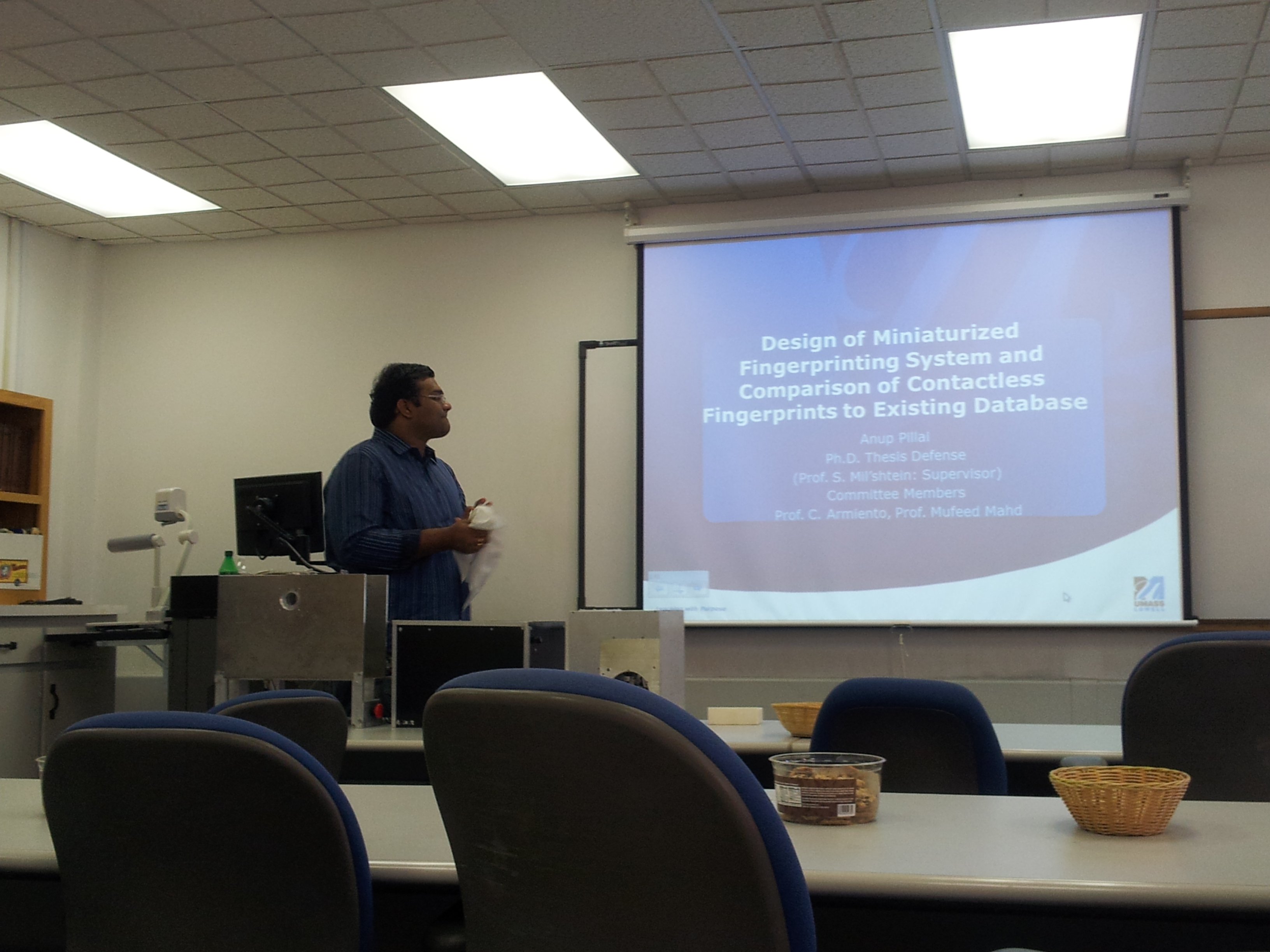
Ph.D. thesis of A.Pillai was turning point in the design of new family of miniature contactless fingerprinting systems which prove to be more reliable and cheaper in production as compared to existing prototypes which have been developed recently at AETC. Figures below show sequence of operation of miniature contactless fingerprinting systems.


On November 13th – 16th doctoral student Anup Pillai and Prof. S. Mil’shtein attended IEEE International Conference on homeland security in Waltham, Massachusetts. Anup Pillai made an oral presentation entitled “Can contactless fingerprinting be compared to an existing database” at morning session of biometrics. The twenty five-minute presentation was extended to about another hour thanks to presence of you people in the room, who were interested in the critical subject of comparison and compatibility between fingerprint libraries, namely, vet ink, digitized fingerprinting, and contactless (touch less) fingerprinting.
Invention Is a Sustainable, Greener Way to Commute
Riding electric bicycles is fast becoming one of the most popular forms of cycling in the country. Not only can it give you the freedom and fun of being a kid again, but it is also a sustainable and environmentally friendly way to commute and run errands.
Christopher Leger, an electrical engineering and math sophomore, and Josiah Hackendorf, a mechanical engineering senior, have created a prototype electric-powered tricycle that would help commuters cut down on air pollution and gas consumption.
“You can use the trike daily for commuting to school,” says Leger, who lives in Tyngsboro. “Its three-wheel design makes it safer and more stable on the road.”
A Low-Cost Alternative Commercial electric bikes can cost anywhere from $400 to more than $1,000. “Do-it-yourselfers can follow our design and build one for only $250,” says Leger.
The trike uses a 500-watt DC motor for the front wheel’s hub, which directly drives the trike at speeds of up to nearly 20 miles per hour. The motor is powered by rechargeable lead-acid batteries that produce a total of 36 volts. A computerized controller adjusts the voltage output and the motor’s speed.
“Our trike has a range of about 40 to 50 miles on a single charge,” notes Leger. “It weighs about 40 pounds, including the batteries.”
The trike still has pedals in case the rider wants to exercise, or when there is an electrical/mechanical breakdown, or the batteries simply run out of juice, he adds.
Next Step: Solar Power
The students are planning to make improvements to the trike’s design next summer, including replacing the rear basket with another seat so two people can ride at the same time. They also plan to add a solar panel, which will be mounted above the riders to power the motor and act as a sun shade.
“With the solar panel, you won’t need a storage battery to operate the trike,” explains Prof. Samson Mil’shtein, director of UMass Lowell’s Advanced Electronic Technology Center and the students’ faculty adviser. “It will run directly off the solar panel. But you can certainly add a battery if you want to ride on a cloudy day. On a sunny day, the panel can run the trike and recharge the battery at the same time.”
____________________________________________________________________________________________________________________________________________________________________
New text book for 16.333, Engineering of Electronic Materials was published
Prof. Sam Mil’shtein, edited and compiled the textbook “Fundamentals of Material Science for Electrical Engineers” ISBN-13; 978-1-119-93992-4, Willey & Sons Inc. 2012
Prof. Sam Mil’shtein attended conferences and chaired a session “Critical Structures and Materials”: ICPS 2012 held at ETH, Zurich
_________________________________________________________________________________________________
Students of Advanced Electronic Technology Center (AETC) build electrical trike
In the mid of August 2012 AETC undergraduate student Chris Leger and graduate student Josiah Hackendorf did finish the design and assembly of electrical trike with the motor installed in the front wheel. The electrical trike carries much better stability than conventional bikes. It has an option for second passenger seat installed above rare wheels. The trike has a gearbox which allows changing the speed when pedaling.
The testing of electrical trike by Chris Leger was filmed (see the picture below).

Next step of this development is the design of solar panel above the head of a driver. The solar panel is expected to have sun tracing system.
______________________________________________________________________________________________________________
Equipment Is Sustainable, Environmentally Friendly
Each weekend, an estimated 54 million Americans mow their lawns, consuming about 800 million gallons of gasoline every year and producing tons of air pollutants. According to the U.S. Environmental Protection Agency (EPA), lawn mowers (like snow blowers, chain saws, leaf blowers and similar gas-powered garden equipment) emit high levels of carbon monoxide, a colorless, odorless, poisonous gas.
“They also emit hydrocarbons and nitrogen oxides, pollutants that contribute to the formation of ozone,” states an EPA report. “While ozone occurs naturally in the upper atmosphere and shields the earth from harmful radiation, ozone at ground level is a noxious pollutant. Ground-level ozone impairs lung function, inhibits plant growth and is a key ingredient of smog.”
Samuel Hamill, a senior electrical engineering student from Lawrence, has created a prototype solar-powered push mower to help cut down on air pollution, gas consumption and noise. “It’s a sustainable, environmentally friendly way of maintaining one’s lawn,” says Hamill, who is scheduled to graduate in May.
His design is part of his capstone project, with Prof. Samson Mil’shtein as faculty adviser. Alan Rux of the Assistive Technology Program supervises all the senior capstone projects.
Hamill’s solar panel generates up to 160 watts, enough to power two small DC motors — one for driving the blades of a regular reel mower to cut grass and the other for turning the solar panel. A pair of photoresistors helps the panel keep track of the sun as the mower moves back and forth across the lawn.
“You don’t need a storage battery to operate the mower,” explains Hamill. “It will run directly off the solar panel. But you can certainly add a battery if you want to mow on a cloudy day. On a sunny day, the panel can run the mower and recharge the battery at the same time.”
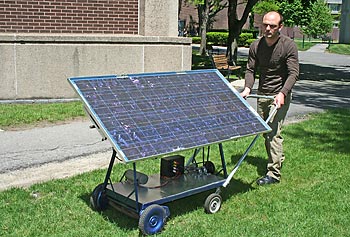
Electrical engineering undergraduate student Samuel Hamill demonstrates the operation of his prototype solar-powered push mower. The mower’s solar panel moves to keep the panel facing the sun
_____________________________________________________________________________________________________________________________________________________________________
Important Events at AETC in December 2011
Winter months are now to bring pandemic of flu, cold in head and other viruses. However this December some of AETC students were bitten by a new virus; they married one after another. The potential impact of these events is easy to evaluate. At the beginning the married student does lose his interest to research and any other activities, with time analytical ability of the individual degrades but after two months the intellectual abilities are slowly coming back and the “thermodynamic equilibrium” is back. These facts are statistically proven and group supervisors should take the situation into account. Now, let us go from generalities to the specific events.
In the month of December two AETC graduate students from Indian, Anup Pillai and Vishal Kunnil were married in a span of 10 days. Below are pictures of AP and VK with their brides during the sacred marriage ceremony. On behalf of AETC faculty and staff we wish these two young families long happy life together and most of all love and harmony.
Anup Pillai with his wife Kavitha

Vishal Kunnil with his wife Neeraja
As mentioned above, “thermodynamic equilibrium” takes place we wish Anup Pillai successful defense of his Ph.D. thesis and Vishal Kunnil to become regional manager of the QUALCOMM division where he started to work recently.
Month of December did bring another pleasant event for AETC. Doctoral student, John Palma, who graduated in the spring semester 2011, became to be the Professor- lecturer John Palma at our ECE department. There are already two ECE faculty, Joel Therrien (now Associate Professor) and John Palma who did their graduate studies with AETC. Our center is known to be very selective with graduate students, whom we invite to join the group. The students usually are gifted and capable and, most important, resourceful individuals. We wish John Palma successful professional career.
Below is a picture of Prof. John Palma at one of his lectures.
Dr. J. Palma educating students basics of Circuit Theory
In February 2012 Scott Wilson, AETC undergraduate student was accepted to EE Dept. Of Cornell University in Ithaca, NY.
In March 2012 Paula Bustos, AETC graduate student (now an engineer with Leadership Program at BAE) was nominated for achievement award by AMES.
Good luck to Paula and Scott!
__________________________________________________________________________________________________________
ECE Students A. Pillai and C. McPherson attend the 2011 IEEE Homeland Security Conference in Waltham, MA
Nov 15, 2011
Doctoral student A. Pillai and undergrad student C. McPherson of the ECE Dept. attended the 2011 IEEE Homeland Security Conference held at Westin Hotel, Waltham, MA. They were demonstrating a contactless handheld fingerprinting system as well as a network protocol secured by using biometrics. The IEEE Conference on Technologies for Homeland Security (IEEE HST) is the leading international conference addressing the challenges of homeland security technology innovation gaps. Since conception, this annual conference has gained prominence and recognition for bringing together science and technology leaders from around the world.
The demonstration was attended by big crowd of conference participants. The leading technology experts did positively comment the novel work being done by students at the Advanced Electronic Technology Center, UML ECE Dept.
Fig. 1. A. Pillai presenting the poster
Fig. 2 C. McPherson making final checks to the machine
__________________________________________________________________________________________________________
Doctoral Student Anup Pillai presents a talk at LDSD 2011, Mexico
Doctoral student Anup Pillai recently attended the International Conference on Low Dimensional Structures and Devices. The conference was held at Telchac, Nuevo Yucatan, Mexico from May 22nd-May 27th, 2011. Anup was giving an oral presentation and also presenting two posters. When asked about his experience at the conference, he had the following to say:-
The conference provided a forum for researchers, engineers, and product development. In addition, the conference also provided me an opportunity to get a broad overview of the field by covering a wide range of growth techniques, materials, nanostructures, characterization, processing, device fabrication, microsystems, applications, and other related topics. It was an indispensable experience as LDSD 2011 was my first international conference outside of United States. This quantum electronic conference had surprisingly large number of solar energy conversion presentations. This indicated to me that a lot of interest is being generated and research is being done in the solar energy conversion area around the world. I also got to experience the Mexican heat and also had a wonderful and a memorable visit to Chechen Itza.

A. Pillai presenting his paper at LDSD 2011 and Prof. S. Mil'shtein feeding him after a good presentation
__________________________________________________________________________________________________________
Researchers Develop Superfast Computer Chip
Processor Can Make PCs 20 Times Faster
Frustrated with slow computers? Tired of waiting for your files to download?
Researchers from the University of Glasgow in Scotland and UMass Lowell have created a new processor that will pave the way for superfast desktop PCs. This technology will be a boon especially for users who work with vast amounts of data, play video games or do heavy graphic editing. “Our processor’s performance, or data throughput, is five gigabytes per second, which is about 20 times faster than microprocessors currently in the market,” says Assoc. Prof. Martin Margala of UMass Lowell’s Electrical and Computer Engineering Department. Margala worked on the project along with Ph.D. student Sai Rahul Chalamalasetti.
Margala says the team was able to achieve this breakthrough by squeezing more than 1,000 cores onto the computer chip, called a Field Programmable Gate Array (FPGA). The core is the part of a computer’s central processing unit (CPU) that reads and executes commands. For comparison, today’s PCs have only two, four or 16 cores.
“We were able to make the FPGA processor run faster by creating more than 1,000 mini-circuits within the FPGA chip,” says Margala. “This effectively turned the chip into a 1,000-core processor, with each core performing a different task.”
In addition to enhanced processing speed, the new chip design consumes very little energy, so it represents a “greener,” more environmentally friendly option.
Although the work is still in an early, proof-of-concept stage, Margala believes that FPGA processors will become more widely used in consumer electronics and will help usher in a new era of high-speed computing.
___________________________________________________________________________________________________________________________________________________
ECE Students Attend Inventor Conference
On Feb. 5, 2010, six members of Prof. Sam Mil’shtein group (AETC),Vishal Oliyil Kunnil, Paula Bustos, Michael Paradis, Michael Baier, Michael Moore, and Josh Northrup, participated at the Invention to Venture workshop sponsored but the National Collegiate Inventors and Innovators Alliance (NCIIA) at the Microsoft NERD Center in Cambridge, MA. This was the first event of a series of workshops that introduces university students-inventors and entrepreneurs to the opportunities of funding and commercialization of their invention. The students made a splash after pitching their “Mobile Contactless Fingerprinting and Blood Vessel Mapping System”, and were asked by NCIIA coordinators to return in April to compete for the promise of commercialization and investor backed funding. When asked about their experience, the students relied that they were grateful for the opportunity to compete and that the opportunity to speak with venture capitalists and established entrepreneurs was a great learning experience, especially for those whose future plans are to have their own businesses. The AETC team was the biggest student group among students from different Massachusetts’s universities and colleges (MIT, Boston University, UMass campuses, and others). In April the AETC team is planning to present to investors three projects ready for commercialization, namely, a mobile fingerprint system; credit card and ATM crime preventing electronics with biometric signature; and a method of reducingelectronic waste generated by computers.
_____________________________________________________________________________________________________________________________________________________________________________
Graduate student Paula Bustos received a special scholarship
Here is what Paula said about the conference:
“Honoring the past, empowering the future” was the motto for this year’s HENAAC Conference organized by the “Great Minds in STEM” organization. The HENAAC conference focuses on identifying, honoring and documenting the contributions of outstanding Hispanic American in science, engineering, technology and math. They are dedicated to highlight Hispanic Talent in the United States. This is the third time I attend this conference and every time I come back home very motivated. The HENAAC conference was a great opportunity to meet professionals who have succeeded in the STEM field. I had the opportunity to network with professionals from companies such as Lockheed Martin, Boeing, Chevron, Ford, NASA, Raytheon, Northrop Grumman, and more. As well, I was able to network with other Engineering students in the United States. I met people from MIT, Penn State, Cal Pomona, and Florida International University. As a scholarship recipient by Booz Allen Hamilton I’m very thankful for the opportunity to attend the HENAAC conference and meet the Hispanic community in the STEM field. This conference does not only highlight the Hispanic talent but also looks to inspire future generations. In my opinion I think they are doing a pretty good job because I’m inspired and moved by the story of the people attending the conference. After three days of extensive work, Great Minds in STEM gave away World Disney passes to the HENAAC attendees. This was my first time in Disney World and it was unforgettable. I always wanted to go to Magic Kingdom and meet Mickey Mouse. This dream has come true! I truly enjoyed the HENAAC conference and I look towards to future ones.


_____________________________________________________________________________________________________________________________________________________________________________
Collaborations between AETC and other research groups
1) AETC-STL (Submillimeter-wave Technology Lab) Project: Photomixing and Detection Applications using BDT (Ballistic Deflection Transistor) technology
The project will be jointly managed by Prof. Margala of AETC and Dr. Guy DeMartinis of STL. The focus of this project is on applications of BDT technology in photomixing and as a detection medium. There has been prior work published in literature that demonstrated the capabilities of ballistic devices in mixing two signals of different frequencies and as phase detectors. In both studies the authors explained the theoretical principles of operation and experimentally demonstrated their findings using lower frequency signals in order to reduce the effect of impedance mismatches in their measurements. The student leading this project is Kevin Rosario.
For more information, click here
2) AETC-NEFCA (New England Forensic Consulting Associates) Project: Comparison of fingerprints taken by ink and paper, live-scan and contact-less technologies
The project will be jointly conducted by Prof. Mil'sthein of AETC and C. Walsh and Drew Webb of NEFCA. Can law enforcement officers use a fingerprint taken from a crime scene and compare it simultaneously to a wet-ink / digitized and touch-less fingerprint. Dominant presence of wet-ink/digitized fingerprints requires that these questions be answered immediately. In this study, we have identified potential problems that will arise during the inter-comparison of the three libraries of fingerprints. The student leading this project is Anup Pillai.

